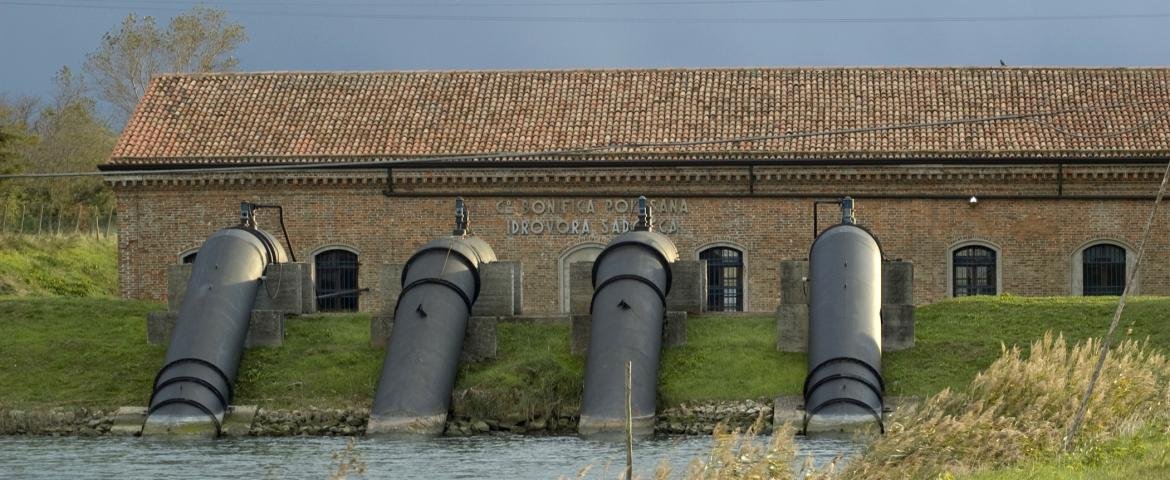
An itinerary of industrial archaeology to understand the titanic challenge of land reclamation
❝The Delta area, which has always been subject to flooding, was transformed through projects of "whole land reclamation" at the beginning of the 20th century. The protagonists of this process were the water drainage pumps, powerful lifting systems designed to drain the amphibious territories and to improved hydraulic safety. A new open-air museum itinerary lets visitors observe the imposing architectural stars of this radical transformation.❞
Walking along the banks of the Po di Venezia it is possible to observe an unusual, green and varied landscape, in which the naturalistic areas of value are flanked by characteristic anthropic elements, all contributing to the evocative scenery of the Delta. Here it is possible to admire the wide floodplains, visited by numerous species of birdlife, or to venture along the "Via delle Idrovore” (Land reclamation and water drainage pumps itinerary), in the Valle Mea, to capture the sense of a slow but unstoppable evolutionary process, which finds expression in the isolated farms and rural houses, as much as in the gigantic yet silent artefacts of industrial archaeology still visible in the area. Among these elements is an interesting structure at the mouth of the Collettore Padano Polesano: the imposing water drainage pump built in order to regulate the water. The artefact, in exposed brick, has, in its central body, the powerful pumps placed above a suction basin, where there are pipes that are positioned in order to discharge the water at higher altitudes.
Other characteristic elements of the historical water pumps include decorative elements in Istrian stone, large windows and chimneys for the steam engines, powerful and effective machines built to regulate water levels which, especially between the two world wars, deeply impacted the Delta economy. Thanks to these pumping systems, which prevented devastating floods by evacuating the stagnant waters, it was possible to construct factories to process agricultural products and, consequently, the safe development of new areas near the urban centres.
With the intention of educating visitors about the ancient structures of hydraulic land reclamation that allowed further human settlement and productive development in the Po Valley, the Po Delta Reclamation Consortium has created the “Via delle idrovore" in the municipal area of Porto Viro. The itinerary of industrial archaeology includes four sites: the Chiavica Emissaria of 1901, the Sadocca Drainage Pump of 1898 (still in operation), the Chiavichetta drainage pump of 1915 and the Ca' Giustinian drainage pump of 1916. The last one also presents an interesting and characteristic well for collecting rainwater. This represents a very topical issue today considering climate change and the growing scarcity of water that even the largest Italian river, the Po, is experiencing. The four hydraulic artifacts, whose recovery was financed by the Veneto Region with the contribution of the Fondazione CARIPARO and the Municipality of Porto Viro, are part of an open-air museum system connected to the Ca’ Vendramin Reclamation Museum, within an itinerary that can be followed on foot, by bike, by car or by pleasure boat.
Here's the information to reach the Sadocca Drainage Pump, a site into the itinerary of industrial archaeology.
By train: the Sadocca Drainage Pump is situated about 11 km from Rosolina station (railway line Rovigo-Adria-Chioggia), with good cycle-rail interchange facilities.
Where to eat:
we suggest Ristorante Baraonda (Via C. Colombo 31, Porto Viro; tel. 0426 666021) and Ristorante La Bitta (Strada Provinciale 64, Porto Levante; tel. 0426 666031 - 335 1621103).
Where to stay:
we recommend Albergo Ristorante e Pizzeria Il Paradello (Via C. Colombo 58, Porto Levante; tel. 0426 666063) and Locanda del Nibbio.
Tours and bike & boat rental:
for bike and horse trips and boat tours please refer to the website of Parco Delta del Po.
The settlements of the Delta people brought to life with the reconstruction of a historic water-drainage pump
An ancient fortified settlement on the Adige river that controlled trade and river traffic
The historical floating artefacts that connect communities across the river
Once an ancient Roman river port and a crossroads of Venetian trade